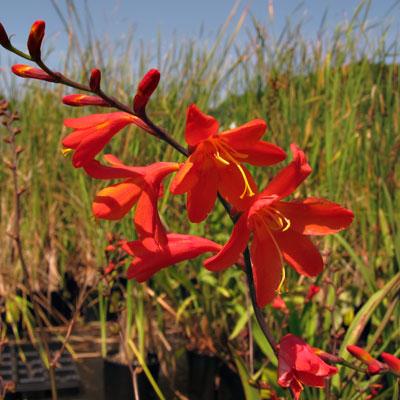Star Gardener: Vibrant Late Summer Flowers

A small composition of perennials in saturated reds and purple-blue with a dash of yellow drew my attention throughout August and into September.
My experiment used three plants that I observed a year ago while studying the perennial plantings at Bressingham Gardens in England with Amy Halsey of Amy’s Flowers in Water Mill. The herbaceous clematis, C. heracleifolia Cassandra, contributes the deep purple/blue; the aptly named Sedum Red Cauli becomes progressively brighter as its buds open, and the classic cultivar Helenium Moerheim Beauty has performed a multicolored show for more than six weeks with blooms opening deep red and turning burnt orange to dark yellow as they age.
The perennial challenge in perennial gardens is how to keep the show going after July. Often gardens begin looking tired after the first flush of summer, or they are filled with gold and yellow daisy-like flowers to the exclusion of most other colors.
The gardens at Bressingham have inspired me to seek ways to extend our garden season with lots of color into September and beyond.
Helenium, sneezeweed or Helen’s Flower, comes in many colors and tones in the red-to-mahogany range, yellow, gold, and orange. It is a native-plant gift to the late summer garden, long-blooming and robust, and it ought to be used more often.
The clear yellow cultivar Butterpat has been flowering for the past month in the Mimi Meehan Native Plant Garden in East Hampton. It’s beautiful, but oh so safe. Why was I so cautious and conservative when I selected it, I’ve been asking myself. Next season, if I can’t locate a local source, my Moerheim Beauty will be transplanted to the native plant garden to join Butterpat and give the area some verve.
Sedums are stalwarts of the late-season garden and Red Cauli deserves to become popular. Its blue-gray succulent leaves are flushed with burgundy, and its stems are burgundy, reminding me of the popular S. Matrona. However, its flowers are about the clearest red of any sedum. Hopefully it will be propagated locally, but in the meantime my very satisfactory plant came from the mail-order nursery Bluestone Perennials.
Crocosmia and Kaffir lilies were important elements in the September beds at Bressingham Gardens. Unfortunately, in my past experience they had not been hardy for me. Their vivid, spikey flowers and sword-like leaves add visual interest that our perennial gardens generally lack.
The most familiar of the crocosmia is the scene-stealer Lucifer, generally grown as an annual corm. Anyone stopping at Breadzilla in Wainscott in July and August knows that when Lucifer is flowering you are blind to all else.
Help is on the way. The wholesale grower Glover Perennials on the North Fork has been trialing a slowly expanding list of hardy cultivars of both crocosmia and Kaffir lilies.
Bright orange Crocosmia Distant Planet is gorgeous and would mix well with other late-summer plants without dominating the garden. There is a second, more subdued cultivar, as well. Let’s put our toes in the water and test them for ourselves. In England and Europe there are dozens of varieties opening from midsummer throughout the remainder of the season and in many colors. Distant Planet could be the beginning of something new.
The various cultivars of the Kaffir lily, Schizostylis coccinea, are among the last perennials to flower, from August into November. Forms hardy in our gardens are to be prized. It’s a member of the iris family and is from South Africa, where it has warm summers and cold winters. This season Glover is offering four cultivars, in colors ranging from light pink to salmon pink and coral red. They say it has performed well in their gardens.
This summer the English garden press has given great exposure to a new red cardinal flower that had me lusting and drooling. I was thrilled to see it available from Glover and one has been planted already in my garden. More to come on its performance next season.
Flowering in August, the red cardinal flower, Lobelia cardinalis, is native to wet woods and damp spaces in our region but is adaptable to the garden. Doug Dayton grew it brilliantly in heavy loam in his astonishing garden behind Wittendale’s Nursery. Adding purple-black foliage to the intense red flower is an irresistible combination, and with a name like Black Truffle, who can resist?
Deep blues and purples are essential companions to anchor these bright perennials. Most of us, unfortunately, are not able to grow and perennialize agapanthus, which accomplishes this brilliantly in English gardens. Aconitum and tender salvias are about as close as we come now.
But my low-growing herbaceous clematis Cassandra should not be forgotten. It is compelling and keeps showing up in the photos I took throughout my stay at Bressingham. I found it at the mail-order Joy Creek Nursery, a must-go-to nursery for any plant lover.
Why don’t we plant for a long, extended season of flowering? There certainly are lots of choices. The answer, I suspect, is that most planting is done in the spring, and people buy plants with curb appeal, meaning when they are in flower. By late July most people have stopped visiting garden centers, so the garden centers stop bringing in fresh plants. It’s a vicious circle. Break it.
